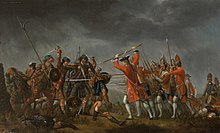The British Grenadiers
History
The exact origins of the tune are disputed but generally date to the early 17th century. It appears in John Playford's 1728 collection of dance tunes as "The New Bath", while Victorian musicologist William Chappell also suggested links to a 1622 work called "Sir Edward Nowell's Delight". The debate is best summarised by the composer Ernest Walker in 1907 who described the melody as "three centuries' evolution of an Elizabethan tune".[2]
The melody was introduced into Britain as a military march during the 1689–1702 reign of
"The British Grenadiers" refers to
It was a popular tune in both Britain and North America throughout the 18th and 19th centuries and remains so.
Lyrics
The following text may date back to the War of Spanish Succession (1702–1713), since it refers to the grenadiers throwing grenades and the men wearing "caps and pouches" (i.e. the tall grenadier caps,[10] worn by these elite troops, and the heavy satchel[11] in which grenades were carried) and "loupèd clothes" – coats with broad bands of 'lace' across the chest that distinguished early grenadiers.[12]
Some talk of Alexander, and some of Hercules
Of Hector and Lysander, and such great names as these.
But of all the world's brave heroes, there's none that can compare.
With a tow, row, row, row, row, row, to the British Grenadiers.
Those heroes of antiquity ne'er saw a cannon ball,
Or knew the force of powder to slay their foes withal.
But our brave boys do know it, and banish all their fears,
With a tow, row, row, row, row, row, for the British Grenadiers.
Whene'er we are commanded to storm the palisades,
Our leaders march with fusees, and we with hand grenades.
We throw them from the glacis, about the enemies' ears.[n 1]
With a tow, row, row, row, row, row, for the British Grenadiers.
And when the siege is over, we to the town repair.
The townsmen cry, "Hurrah, boys, here comes a Grenadier!
Here come the Grenadiers, my boys, who know no doubts or fears!
Then sing tow, row, row, row, row, row, for the British Grenadiers.
Then let us fill a bumper, and drink a health of those
Who carry caps and pouches, and wear the loopèd clothes.
May they and their commanders live happy all their years.
With a tow, row, row, row, row, row, for the British Grenadiers.
Before the American Revolution, Joseph Warren wrote a parody song called "Free America" to the same tune.
Historical terms

There are a number of words in the song not commonly used or whose meaning is obscure:[13]
- Fusee: shortened muskets carried by Grenadier officers, sometimes called fusils.[n 2] This is accurately depicted in David Morier's painting of the Highland charge at the Battle of Culloden: the Government troops are grenadiers and their officer wields a fusil.
- Glacis: a smooth sloping embankment usually in front of the walls of a fort; designed to deflect cannonballs, it also gave defenders a clear field of fire, making it a dangerous place to stand upright and throw grenades.
- Bumper: any drinking container used in a toast, normally filled with beer or other alcoholic drink.
- Loupèd: 'looped' pronounced "loup-ed" to scan; it refers to the lace button-holes or 'loops' on grenadier uniforms.
- Tow, row, row, row: mimics the rhythm and beat of the drums used to keep soldiers in step.
See also
- Grenadier Guards Band
Notes
References
- ^ Ken Anderson Msc (2007). "The Early Days of Digital Computing in the British Army". p.31.
- ISBN 1334045305.
- JSTOR 737882.
- ^ Goode, Domi. "Namur 1695". Fortified Places. Retrieved 28 February 2018.
- ISBN 0789000997.
- ^ Grose, F. (1786). Military Antiquities Respecting a History of the English Army. p. 180.
- ^ "The British Grenadiers". Tune Arch. Retrieved 28 February 2018.
- ^ "Trooping of Colour marks Queen's Official Birthday". The Telegraph. Retrieved 3 June 2012.
- ^ "Sheffield (English)" at Hymnary.org, retrieved 28 July 2012
- ISBN 0-684-15130-8.
- ISBN 0-684-15130-8.
- ISBN 0-684-15130-8.
- ^ "British Grenadiers". The First Foot Guards reenactment group. Retrieved 7 January 2007.
External links
- The Original 1750s Lyrics to The British Grenadiers Shows how the lyrics evolved from a soldier's song to something more palatable to the educated classes of British society. There was no "bumper", "looped" or "tow row row row" in the original version of the song. The first words began: "Some boast of Alexander".
- Lyrics and some explanation of unusual words
- The Virtual Grammophone, Canadian Historical Sound Recordings, Marches, British Grenadiers (regimental march of the Canadian Grenadier Guards) ram (RealPlayer)
- The official site of the Grenadier Guards Band.
- "The British Grenadiers – Quick March of the Grenadier Guards " on YouTube

